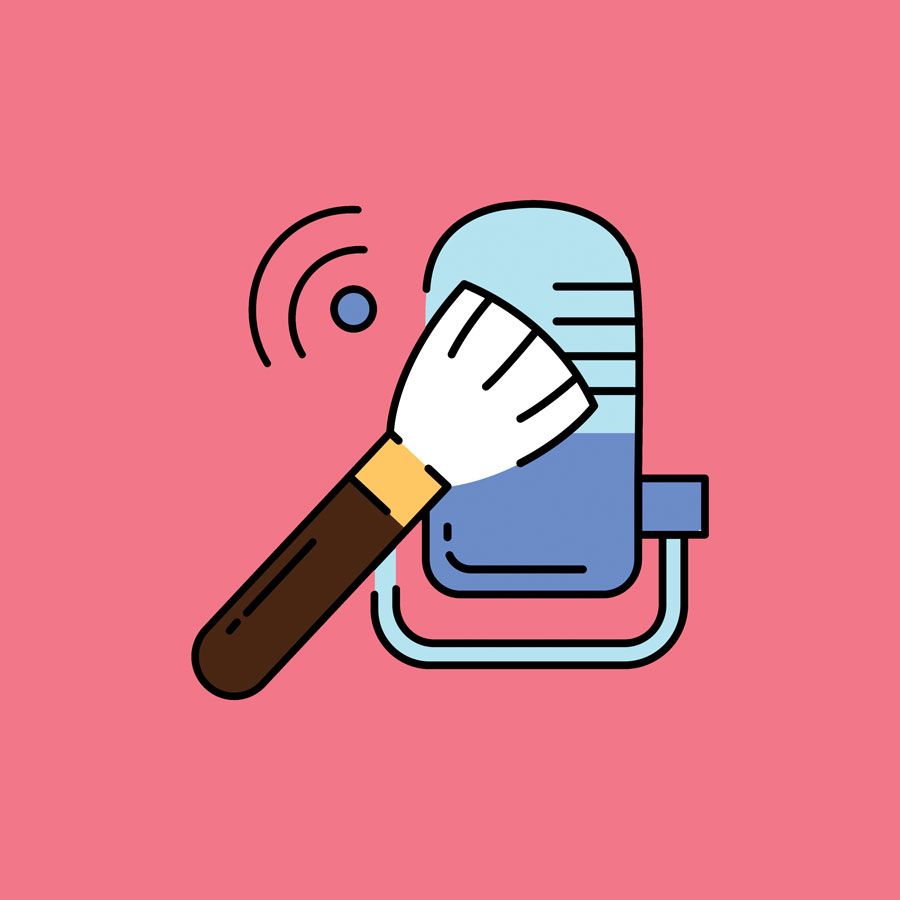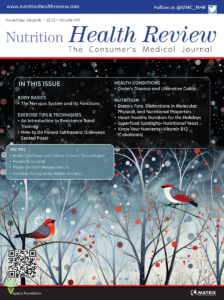
By Sarabeth Lowe, MPH
Ms. Lowe is a Communication Specialist at the University of Delaware Disaster Research Center.
A woman leans in toward a microphone, looking directly into the camera, and whispers softly. A makeup brush gently taps against its container; tiny particles of glitter puff into the air. The sizzle of oil hits a hot pan. The gentle snip of scissors trimming hair. The crisp sound of a book’s pages being turned. The sounds are subdued, never alarming. They’re just loud enough to keep a viewer’s attention.1
Some people might find these vivid scenarios annoying, even aggravating. For others, though, these sights and sounds can trigger a sensory phenomenon called autonomous sensory meridian response (ASMR)—a pleasant, warm, tingling sensation that begins at the crown of the head and cascades down the spine.2–4 This sensation is triggered by specific auditory and visual stimuli, usually ones that involve positive, personal attention and/or crisp sounds and slow movements.3,5–7 ASMR is often accompanied by subsequent feelings of calmness and relaxation.
There has not been enough research on this topic to gauge how many people experience ASMR, but some studies estimate that roughly 20 percent of people have this response.2,3,8 At the same time, the experience is subjective, and triggers can vary from person to person.2–4 As this body of research continues to grow, experts will be able to better explain ASMR and its potential therapeutic uses. Here is what we know so far.
Anatomy of ASMR
When most people experience ASMR, it’s a feeling. For researchers, though, it’s a physical response. Several studies in the last decade have shed light on how this response is carried out in the body. It all comes down to one consensus: ASMR triggers, which range from video to audio and more, activate specific regions of the brain, which produce the feelings commonly associated with the response.
A small 2018 study involving 10 participants looked at functional magnetic resonance imaging (fMRI) scans of each test subject while they viewed ASMR videos.9 Researchers found that their brains showed significant activity in the areas that control emotion and empathy, as well as areas associated with social engagement and positive personal attention.6,10 Subsequent studies have echoed these results and taken it further. Here are some of their main findings:
- ASMR sensations fall into two main categories: physical and psychological. Physical sensations (i.e., what you feel) might include light and pleasurable tingles, sparkles, fuzziness, or waves of relaxation in the head, neck, spine, and throughout the rest of the body.2–4,10,11
- Researchers have found that neurohormones, such as dopamine, oxytocin, and endorphins, might be responsible for the feelings of comfort, relaxation, and sleepiness resulting from ASMR exposure.1,10 This positive impact on people’s affect is a defining characteristic of ASMR.2,12–15
- Not all triggers are created equal. A 2017 paper showed that auditory triggers may stimulate a response more readily than visual ones.16
- ASMR is a non-universal and subjective experience, which can make people with the condition feel isolated. Those who do feel it, however, typically assume that ASMR is either a universal experience or one unique to them. ASMR tends to start in childhood.2,13
- Because ASMR is subjective, the experience varies from person to person. However, most people with ASMR describe it as tingles that start at the top of the body (usually in the head or neck) and cascade down the spine to the rest of the body.2,3,6,11 Another common description portrays ASMR as a wave of relaxation and calmness that moves in the same direction.
- ASMR can be intentional or unintentional.11,14 The former occurs when someone tries to elicit an ASMR response. This can be accomplished by watching videos, listening to music, or performing a sensory task to elicit an ASMR response, such as knitting. The latter occurs when something or someone triggers an ASMR response in a person when they are not intentionally seeking one. These might include interactions with clinicians, hairdressers, and teachers. Both elicit similar responses.2,11,14
Setting the Stage: Context and Triggers
ASMR doesn’t happen in a vacuum. To stimulate an ASMR response, you need to consider two main factors: context and triggers.11,16–18
Context sets the stage for experiencing ASMR.11 Contextual factors include the setting (e.g., time of day, local environment, location, in-person vs. virtual), distance from the person or object, and the type of trigger. If the trigger is a person, the nature of the relationship or interaction is a key factor. For example, you are most likely to experience ASMR when you feel safe and are receiving calm, focused attention.3,8,11,16,17
Triggers are the specific stimulation that elicits ASMR.11 These triggers, which can be auditory, visual, tactile, and/or olfactory, tend to be gentle, nonthreatening, and calm in nature.8,11,17 This response can be induced, in those who are susceptible, by a fairly consistent set of triggers. A 2023 study surveyed 295 subjects to identify the most common triggers, listed below:18
- Physical touch on your body
- Soft-speaking
- Brushing sounds
- Delicate hand movements
- Whispering
- Light touch on your face
- Tapping sounds
- Close personal attention toward you
- Nature sounds
- Page-turning sounds
Potential Therapies
It is not uncommon for ASMR adherents to be seeking its effects where other interventions, health or otherwise, have failed.3 That’s why some experts have begun exploring ASMR as a complementary or integrative approach to certain mental health conditions. Though research in this area is still in its early stages, ASMR has been linked to several potential health benefits in those who experience it.
Improved mood. Several studies and anecdotal reports have described the mood-boosting benefits of ASMR.5,7,14 A 2015 article revealed that 80 percent of the study’s nearly 500 subjects reported ASMR exposure affecting their mood.3 Notably, the effects were most apparent when participants were engaging with ASMR and faded after several hours.
Chronic pain. In the same 2015 study, researchers found a significant difference in chronic pain symptoms before and during ASMR, a difference that was maintained three hours following the exposure.3
Increased attention. Various anecdotal reports of ASMR and numerous studies have shown that ASMR can induce a “flow-like state,” an intense, deeply immersive sense of relaxation, focus, and engagement.2,3,13–15 This mental state, which can diminish awareness of the passage of time, is often linked to optimal performance in certain activities, such as sports and academics.
Sleep. Experts have started to explore ASMR as a complementary health approach to improving sleep, and some have used it for that purpose.2 Results from several studies have suggested that ASMR helps lead to sleep by relaxing mental states and reducing anxiety.3,9 Still, ASMR’s physical effects on the body, including decreased heart and breathing rates as well as blood pressure, are also conducive to better sleep.2,3,19–21
Bottom Line
While ASMR is not a new phenomenon, research on its implications for public health is still in its early stages. Only in the last 15 years has ASMR become a mainstream topic of interest.5,6,10 Since then, it has taken the internet by storm. Given the increased rate of mental health disorders, experts are urging researchers to explore additional avenues of treatment, including ASMR.22–24 Even as research continues to show its potential for therapeutic use, many unanswered questions remain.2–6,16,20
Sources
- Kircher MM. Is everything A.S.M.R. now? New York Times. 11 May 2024. Accessed 15 Sep 2024. https://www.nytimes.com/2024/05/11/style/asmr-video.html
- Poerio GL, Blakey E, Hostler TJ, Veltri T. More than a feeling: autonomous sensory meridian response (ASMR) is characterized by reliable changes in affect and physiology. PLoS One. 2018;13(6):e0196645.
- Barratt EL, Davis NJ. Autonomous sensory meridian response (ASMR): a flow-like mental state. PeerJ. 2015;3:e851.
- Gerry LM. What is ASMR? Verywell Health. 13 Aug 2022. Accessed 15 Sep 2024. https://www.verywellmind.com/what-is-asmr-4582673
- Lloyd JV, Ashdown TPO, Jawad LR. Autonomous sensory meridian response: what is it? And why should we care? Indian J Psychol Med. 2017;39(2):214–215.
- Richard C. The brain science (and benefits) of ASMR. TED. Nov 2019. Accessed 15 Sep 2024. https://www.ted.com/talks/craig_richard_the_brain_science_and_benefits_of_asmr
- Sakurai N, Nagasaka K, Takahashi S, et al. Brain function effects of autonomous sensory meridian aesponse (ASMR) video viewing. Front Neurosci. 2023;17:1025745.
- Fredborg B, Clark J, Smith SD. An examination of personality traits associated with autonomous sensory meridian response (ASMR). Front Psychol. 2017;8:247.
- Lochte BC, Guillory SA, Richard CAH, Kelley WM. An fMRI Investigation of the neural correlates underlying the autonomous sensory meridian response (ASMR). Bioimpacts. 2018;8(4):295–304.
- Marcin A. What is ASMR? Your guide to tapping into relaxation. Healthline. 19 Apr 2022. Accessed 15 Sep 2024. https://www.healthline.com/health/autonomous-sensory-meridian-response
- ASMR University.What is ASMR? Accessed 20 Sep 2024. https://asmruniversity.com/about-asmr/what-is-asmr/
- Poerio GL, Ueda M, Kondo HM. Similar but different: high prevalence of synesthesia in autonomous sensory meridian response (ASMR). Front Psychol. 2022;13:990565.
- Poerio G. Could insomnia be relieved with a YouTube video? The relaxation and calm of ASMR. In: Callard F, Staines K, Wilkes J, eds. The Restless Compendium: Interdisciplinary Investigations of Rest and Its Opposites. Basingstoke (UK): Palgrave Macmillan; 2016. Available from: https://www.ncbi.nlm.nih.gov/books/NBK453209/
- Jividen S. Triggers and Sensations of Autonomous Sensory Meridian Response (ASMR). Verywell Health. 6 Jun 2024. Accessed 20 Sep 2024. https://www.verywellhealth.com/autonomous-sensory-meridian-response-5220951
- Csikszentmihalyi M. The concept of flow. In: Sutton-Smith B, ed. Play and Learning. New York: Gardner Press; 1979:257–274.
- Barratt EL, Spence C, Davis NJ. Sensory determinants of the autonomous sensory meridian response (ASMR): understanding the triggers. PeerJ. 20176;5:e3846.
- Smith SD, Katherine Fredborg B, Kornelsen J. An examination of the default mode network in individuals with autonomous sensory meridian response (ASMR). Soc Neurosci. 2017;12(4):361–365.
- Poerio GL, Succi A, Swart T, et al. From touch to tingles: assessing ASMR triggers and their consistency over time with the ASMR trigger checklist (ATC). Conscious Cogn. 2023;115:103584.
- Lee M, Song CB, Shin GH, Lee SW. Possible effect of binaural beat combined with autonomous sensory meridian response for inducing sleep. Front Hum Neurosci. 2019;13:425.
- Woods N, Turner-Cobb JM. ‘It’s like taking a sleeping pill’: student experience of autonomous sensory meridian response (ASMR) to promote health and mental wellbeing. Int J Environ Res Public Health. 2023;20(3):2337.
- Engelbregt HJ, Brinkman K, van Geest CCE, et al. The effects of autonomous sensory meridian response (ASMR) on mood, attention, heart rate, skin conductance and EEG in healthy young adults. Exp Brain Res. 2022;240(6):1727–1742.
- Wu Y, Wang L, Tao M, et al. Changing trends in the global burden of mental disorders from 1990 to 2019 and predicted levels in 25 years. Epidemiol Psychiatr Sci. 2023;32:e63
- Blanchflower DG, Oswald AJ. Trends in extreme distress in the United States, 1993–2019. Am J Public Health. 2020;110(10):1538–1544.
- US Department of Health and Human Services. US Surgeon General issues advisory on the mental health and well-being of parents. 28 Aug 2024. Accessed 25 Sep 2024. https://www.hhs.gov/about/news/2024/08/28/us-surgeon-general-issues-advisory-mental-health-well-being-parents.html





